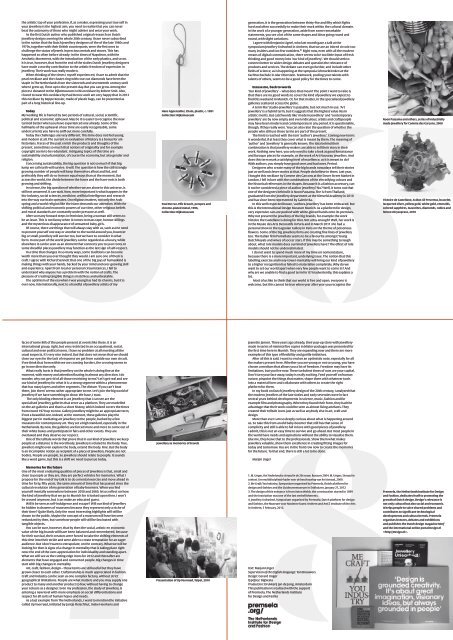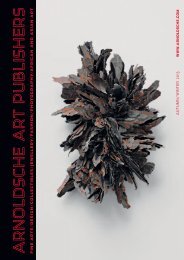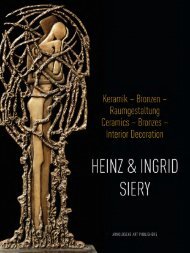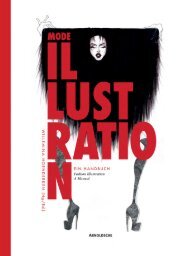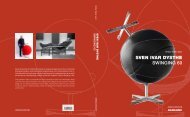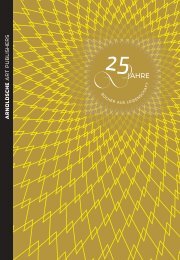Freedom has its limitations Jewellery today, seen from ... - Arnoldsche
Freedom has its limitations Jewellery today, seen from ... - Arnoldsche
Freedom has its limitations Jewellery today, seen from ... - Arnoldsche
You also want an ePaper? Increase the reach of your titles
YUMPU automatically turns print PDFs into web optimized ePapers that Google loves.
Robert Smit, Necklace Sketch for Sleeping Beauty II,<br />
the artistic top of your profession. If, as a maker, expressing your true self in<br />
gold and wire, 1990, Collection: Rijksmuseum<br />
generation, it is the generation between thirty-five and fifty which fights<br />
your jewellery is the highest aim, you need to realise that you can never<br />
hard and often successfully to make their mark within the cultural domain.<br />
beat the autonomy of those who might admire and wear your work.<br />
The author in 1952<br />
In the work of a younger generation, aside <strong>from</strong> some remarkable<br />
As the first Dutch author who published original research on Dutch<br />
jewellery design covering the whole 20th century, I have never subscribed<br />
Van den Eersten & Hofmeier, Chain with pendant,<br />
statements, you see a lot of the same shapes and ideas going round and<br />
round, with slight variations.<br />
to the notion that the Dutch jewellery designers of the of the late 1960s and<br />
amber and gold, c. 1925, Collection: Rijksmuseum<br />
I agree with Benjamin Lignel, who last month gave a talk at the<br />
1970s, together with their British counterparts, were the first ones to<br />
symposium <strong>Jewellery</strong> Unleashed in Arnhem, that we are an inbred circuit: too<br />
challenge the status of jewels in precious metals and stones. This <strong>has</strong><br />
Studio Makkink & Bey, Rotterdam, 2012<br />
many insiders and too few outsiders.<br />
happened so often before already: in the times of Napoleon, with the<br />
Aesthetic Movement, with the introduction of the early plastics, and so on.<br />
The author’s bookshelves<br />
It is true, however, that <strong>from</strong> the end of the sixties Dutch jewellery designers<br />
have made a worthy contribution to the artistic freedom of expression in<br />
jewellery. Their work was really modern.<br />
Juan Pantoja de la Cruz, Portrait of the Infanta Anna<br />
Munchwerk_Opmaak 1 23-02-12 09:01 Pagina 25<br />
of Spain, adorned with all kinds of amulets, 1602,<br />
When thinking of the times I myself experienced, I have to admit that the<br />
Collection: British Museum<br />
pearl necklace and the cluster-ring with rose-cut diamonds have been the<br />
staple in The Netherlands <strong>from</strong> the sixteenth and seventeenth century until<br />
Copper ring with two cannons and a sword, symbol<br />
when I grew up, if not up to the present day. But you can grow. Among the<br />
of power, Central Africa, early twentieth century<br />
pieces I donated to the Rijksmuseum is this necklace by Robert Smit. Also,<br />
I loved to wear this necklace by Paul Derrez and I am very happy that in 2013<br />
Chris Steenbergen, Skipping Rope brooch,<br />
this necklace by Beppe Kessler, made of plastic bags, can be presented as<br />
Robert gold wire, Smit, silver, Necklace partly Sketch gold-plated, for Sleeping 1954, Beauty II,<br />
part of a long historical line-up.<br />
gold Collection: and wire, Rijksmuseum 1990, Collection: Rijksmuseum<br />
Today<br />
The Hans author Appenzeller, in 1952Chain,<br />
plastic, c. 1981<br />
My working life is framed by two periods of cultural, social, scientific,<br />
Collection: Rijksmuseum<br />
political and economic upheaval. May be it is easier to recognise the new<br />
Van den Eersten & Hofmeier, Chain with pendant,<br />
turmoil better when you have experienced one already. Some of the<br />
amber Paul Derrez, and gold, Pills brooch, c. 1925, Collection: perspex and Rijksmuseum<br />
hallmarks of the upheaval of our time are easily recognisable, some<br />
chrome-plated metal, 1996,<br />
undercurrents you have to sniff out more carefully.<br />
Studio Collection: Makkink Rijksmuseum & Bey, Rotterdam, 2012<br />
Today the challenges are very different. This time does not feel young<br />
and modern at all. The current re-evaluation of history is a bonus for art-<br />
The Noon author’s Passama bookshelves<br />
and others, series of industrially<br />
historians. Traces of the past enrich the products and thoughts of the<br />
made jewellery for Comme des Garçons, 2000<br />
present, sometimes 5so much that notions of originality and for example<br />
Juan Pantoja de la Cruz, Portrait of the Infanta Anna<br />
copyright seem to be redundant. Intriguing topics of this time are<br />
Victoire of Spain, de adorned Castellane, with Acidae all kinds Lili of Pervertus, amulets, bracelet, 1602,<br />
sustainability and urbanisation, of course the economy, but also gender and<br />
lacquered Collection: silver, British yellow Museum gold, white gold, emeralds,<br />
religion.<br />
colored sapphires, tsavorites, diamonds, rubies and<br />
Concerning sustainability, the big question is not so much if that big<br />
lemon Copper chrysoprase, ring with two 2010 cannons and a sword, symbol<br />
lump we call earth will survive. It will. The question is how the still strongly<br />
of power, Central Africa, early twentieth century<br />
growing number of people will keep themselves afloat and fed, and<br />
<strong>Jewellery</strong> as memories of travels<br />
preferably they will do so in more equal ways than at the moment. But<br />
Chris Steenbergen, Skipping Rope brooch,<br />
across the world, the divide between the haves and the have-nots is both<br />
Presentation gold wire, silver, of Op partly Voorraad, gold-plated, Taipei, 1954, 2010<br />
growing and shifting.<br />
Collection: Rijksmuseum<br />
In science, the big question of whether we are alone in this universe, is<br />
Premsela, the Netherlands Institute for Design<br />
still not answered. It can wait. Now, more important is what happens in the<br />
and Hans Fashion, Appenzeller, dedicates Chain, <strong>its</strong>elf plastic, to promoting c. 1981 the<br />
bio-industry, social sciences, medicine, artificial intelligence and research<br />
growth Collection: of Dutch Rijksmuseum design. Design’s relevance is<br />
into the way our brain operates. On religious matters, not only the Arab<br />
not only cultural but also social and economic.<br />
spring and a world religion like the Islam demands our attention. With the<br />
It Paul helps Derrez, people Pills to brooch, solve shared perspex problems and and<br />
shifting political and economic powers of our time, other religious beliefs<br />
contributes chrome-plated to significant metal, 1996, technological<br />
and moral standards are constantly under pressure as well.<br />
developments Collection: Rijksmuseum and cultural trends. Premsela<br />
After so many forward steps in feminism, being a woman still seems to<br />
organises lectures, debates and exhibitions<br />
be an issue. This is not funny when it comes to mass rape, honour-killings<br />
and Noon publishes Passama the and Dutch others, design series magazine of industrially Morf<br />
and the mysterious disappearance of unwanted baby-girls.<br />
and made the jewellery international for Comme online des portal Garçons, Design.nl 2000<br />
Of course, there are things that will always stay with us, such as the need<br />
.<br />
to present yourself one way or another to the world around you, however<br />
Victoire de Castellane, Acidae Lili Pervertus, bracelet,<br />
big or small. <strong>Jewellery</strong> will survive too, but we have to consider in what<br />
lacquered silver, yellow gold, white gold, emeralds,<br />
form. In one part of the world jewellery can be regarded as a luxury, while<br />
colored sapphires, tsavorites, diamonds, rubies and<br />
elsewhere it can be <strong>seen</strong> as an element that connects you to your roots. In<br />
lemon chrysoprase, 2010<br />
some dreadful places jewellery may function as the last sign of self-respect.<br />
In a time that changes in so many ways, some traditions can become<br />
<strong>Jewellery</strong> as memories of travels<br />
worth more than you ever thought they would. I am sure one of them is<br />
craft. I agree with Richard Sennett that one of the big joys of humankind is<br />
Presentation of Op Voorraad, Taipei, 2010<br />
making things with your hands, backed by your mind and ever-growing skill<br />
and experience. Apart <strong>from</strong> local or personal circumstances, I fail to<br />
Premsela, the Netherlands Institute for Design<br />
understand why anyone <strong>has</strong> a problem with the notion of crafts. The<br />
and Fashion, dedicates <strong>its</strong>elf to promoting the<br />
pleasure of creating tangible things is matchless and unbeatable.<br />
growth of Dutch design. Design’s relevance is<br />
The optimism of the era when I was young <strong>has</strong> had <strong>its</strong> charms, but it is<br />
not only cultural but also social and economic.<br />
over now. Internationally, next to a handful of jewellery artists of my<br />
It helps people to solve shared problems and<br />
contributes to significant technological<br />
developments and cultural trends. Premsela<br />
organises lectures, debates and exhibitions<br />
and publishes the Dutch design magazine Morf<br />
and the international online portal Design.nl<br />
6Munchwerk_Opmaak 1 23-02-12 09:01 Pagina 25<br />
.<br />
Munchwerk_Opmaak 1 23-02-12 09:01 Pagina 16<br />
Robert Smit, Necklace Sketch for Sleeping Beauty II,<br />
gold and wire, 1990, Collection: Rijksmuseum<br />
4 Van den Eersten & Hofmeier, Chain with pendant,<br />
amber and gold, c. 1925, Collection: Rijksmuseum<br />
Studio Makkink & Bey, Rotterdam, 2012<br />
Munchwerk_Opmaak 1 23-02-12 09:01 Pagina 25<br />
The author’s bookshelves<br />
Juan Pantoja de la Cruz, Portrait of the Infanta Anna<br />
Right now, even with all the modern<br />
of Spain, adorned with all kinds of amulets, 1602,<br />
means of digital communication, there seems to be too little input of fresh<br />
Collection: British Museum<br />
thinking and good money into ‘our kind of jewellery’. We should seek to<br />
connect better to wider design debates and question the relevance of<br />
Copper ring with two cannons and a sword, symbol<br />
products and services. The debate can even go further, and include other<br />
fields of science, as is happening at the symposia SchmuckDenken at the<br />
of Robert power, Smit, Central Necklace Africa, Sketch early for twentieth Sleeping Beauty centuryII,<br />
gold and wire, 1990, Collection: Rijksmuseum<br />
Fachhochschule in Idar Oberstein. Teamwork, pooling your talents with<br />
Chris Steenbergen, Skipping Rope brooch,<br />
talents of others, seems to be a good policy for the times to come.<br />
gold The author wire, silver, in 1952 partly gold-plated, 1954,<br />
Collection: Rijksmuseum<br />
Excuse me, back to words<br />
Van den Eersten & Hofmeier, Chain with pendant,<br />
‘Our kind of jewellery’ – what does that mean? The point I want to raise is<br />
Hans amber Appenzeller, and gold, c. Chain, 1925, Collection: plastic, c. 1981 Rijksmuseum<br />
that there are no good words to cover the kind of jewellery we expect to<br />
Collection: Rijksmuseum<br />
find this weekend in Munich. Or, for that matter, in the specialised jewellery<br />
Studio Makkink & Bey, Rotterdam, 2012<br />
galleries scattered across the globe.<br />
Paul Derrez, Pills brooch, perspex and<br />
A term like ‘studio-jewellery’ is passable, but not much in use. ‘Art<br />
chrome-plated The author’s bookshelves<br />
metal, 1996,<br />
jewellery’ is a hybrid term, but it suggests that the highest value lies in<br />
Collection: Rijksmuseum<br />
artistic mer<strong>its</strong>. But catchwords like ‘modern jewellery’ and ‘contemporary<br />
Juan Pantoja de la Cruz, Portrait of the Infanta Anna<br />
jewellery’ are by now empty and even ridiculous; artists and craftspeople<br />
Noon of Spain, Passama adorned and with others, all kinds series of of amulets, industrially 1602,<br />
may have been modern and contemporary in any period. It is questionable,<br />
made Collection: jewellery British for Museum Comme des Garçons, 2000<br />
though, if they really were. You can also raise the question of whether the<br />
people who still use those terms are part of the present.<br />
Victoire Copper ring de Castellane, with two cannons Acidae Lili and Pervertus, a sword, bracelet, symbol<br />
The limit is reached with the tem ‘author’s jewellery’. Coining new terms<br />
lacquered of power, Central silver, yellow Africa, gold, early white twentieth gold, century emeralds,<br />
is wonderful, if at least they cover what is meant by them. The meaning of<br />
colored sapphires, tsavorites, diamonds, rubies and<br />
‘author’ and ‘jewellery’ is generally known. The idea behind their<br />
lemon Chris Steenbergen, chrysoprase, Skipping 2010 Rope brooch,<br />
Munchwerk_Opmaak 1 23-02-12 09:01 Pagina 25<br />
Robert Smit, Necklace Sketch for Sleeping Beauty II,<br />
gold and wire, 1990, Collection: Rijksmuseum<br />
The author in 1952<br />
combination is that jewellery makers are able to tell their story in their<br />
gold wire, silver, partly gold-plated, 1954,<br />
work. Nothing new here, you only need to take a look at good Renaissance<br />
<strong>Jewellery</strong> Collection: as Rijksmuseum<br />
memories of travels<br />
and Baroque pieces for example, or the work of Art Nouveau jewellers. And<br />
does this term mark a satisfying level of excellence, as it is meant to do?<br />
Presentation Hans Appenzeller, of Op Chain, Voorraad, plastic, Taipei, c. 1981 2010<br />
With authors, you simply have good ones and bad ones. Period.<br />
Collection: Rijksmuseum<br />
Designers who create many of the big brands nowadays tell their stories<br />
Premsela, the Netherlands Institute for Design<br />
just as well and clever stories at that. People do believe in them. Last year,<br />
and Paul Fashion, Derrez, Pills dedicates brooch, <strong>its</strong>elf perspex to promoting and the<br />
I bought this necklace by Comme des Garcons at the Dover Street Market in<br />
growth chrome-plated of Dutch metal, design. 1996, Design’s relevance is<br />
London. I fell in love with the combinations of the electrifying colours and<br />
not Collection: only cultural Rijksmuseum but also social and economic.<br />
the historical references in the shapes. Because it is a fashion accessory, can<br />
It helps people to solve shared problems and<br />
it not be considered a piece of author jewellery? No? Well, it turns out that<br />
contributes Noon Passama to significant and others, technological<br />
series of industrially<br />
one of the designers behind it is Noon Passama. She is <strong>from</strong> Thailand,<br />
developments made jewellery and for cultural Comme trends. des Garçons, Premsela 2000<br />
graduated <strong>from</strong> the jewellery department at the Rietveld Academy in 2010<br />
organises lectures, debates and exhibitions<br />
and <strong>has</strong> since been represented by Galerie Ra.<br />
and Victoire publishes de Castellane, the Dutch Acidae design Lili magazine Pervertus, Morf bracelet,<br />
In this well respected house, ‘authors-jewellery’ <strong>has</strong> been embraced. But<br />
and lacquered the international silver, yellow online gold, portal white Design.nl gold, emeralds,<br />
this is the International Design Museum Munich. As a platform for design,<br />
.<br />
colored sapphires, tsavorites, diamonds, rubies and<br />
very expensive cars are pushed with white-gloved hands onto <strong>its</strong> premises.<br />
lemon chrysoprase, 2010<br />
Why not present the jewellery of the big brands, for example the work<br />
Victoire the Castellane is doing for Dior. Not artsy enough? Well, her work is<br />
<strong>Jewellery</strong> as memories of travels<br />
in the Musée des Arts Decoratifs in Paris and in March 2011 she had a<br />
personal show in the Gagosian Gallery in Paris on the theme of poisonous<br />
Presentation of Op Voorraad, Taipei, 2010<br />
flowers. Some of the big jewellery firms are creating fine lines of jewellery<br />
too. The Italian firm Pomellato seems to be a favourite amongst Young<br />
Premsela, the Netherlands Institute for Design<br />
Dutch Royals and wives of soccer stars. If this may be something to laugh<br />
and Fashion, dedicates <strong>its</strong>elf to promoting the<br />
about, what role models does our kind of jewellery have? The effect of role<br />
growth of Dutch design. Design’s relevance is<br />
models should not be underestimated.<br />
not only cultural but also social and economic.<br />
I do not want to spend much more of my time on nomenclature,<br />
It helps people to solve shared problems and<br />
because there is a more important, underlying issue. The notion that this<br />
contributes to significant technological<br />
labelling exercise and ivory-tower-mentality will bring our kind of jewellery<br />
developments and cultural trends. Premsela<br />
to a higher recognition <strong>has</strong> failed to materialise completely. Why do we<br />
organises lectures, debates and exhibitions<br />
want to set our world apart when very few people want to come in? And<br />
and publishes the Dutch design magazine Morf<br />
why are we unable to find a good term for it? Inadvertently, this explains a<br />
and the international online portal Design.nl<br />
lot.<br />
.<br />
Most of us like to think that our world is free and open, everyone is<br />
welcome, but this cannot be true when year after year you recognise the<br />
Munchwerk_Opmaak 1 23-02-12 09:01 Pagina 15<br />
Van den Eersten & Hofmeier, Chain with pendant,<br />
amber and gold, c. 1925, Collection: Rijksmuseum<br />
Studio Makkink & Bey, Rotterdam, 2012<br />
The author’s bookshelves<br />
faces of some 80% of the people present at events like these. It is an<br />
international group, right, but very restricted in an occupational, social,<br />
cultural and even political sense. I have no problem at all meeting all the<br />
usual suspects, it’s very nice indeed. But that does not mean that we should<br />
close our eyes for the lack of response we get <strong>from</strong> outside our own circuit.<br />
If we think that <strong>from</strong> within we are crossing borders, the crossing seems to<br />
go in one direction only.<br />
What really hurts is that jewellery on the whole is doing fine at the<br />
moment, with money and attention floating in almost any direction. I do<br />
wonder, why not get rid of all those restricting terms? Let’s get real and see<br />
our kind of jewellery for what it is: a strong segment within a phenomenon<br />
that <strong>has</strong> many layers and other segments. The dictum ‘if you can’t beat<br />
them, join them’ seems rather appropriate to me. Let’s join the big world of<br />
jewellery if we have something to show. We have, I trust.<br />
The only binding element in art jewellery that I can see are the<br />
specialised jewellery galleries that serve as a platform. They are modelled<br />
on the art galleries and that is a short history, which indeed covers the times<br />
<strong>from</strong> round 1970 up to now. Gallery jewellery might be an appropriate term,<br />
if not a beautiful one. Indeed, at the moment, these galleries play the<br />
biggest part in mediating art jewellery to the people, backed by a few<br />
museums for contemporary art. They set a high standard, especially in The<br />
Netherlands. By now, the galleries are forced more and more to come out of<br />
their white boxes and participate in fairs and other events. They are<br />
overtaxed and they deserve our respect.<br />
One of the telltale words that prove that in our kind of jewellery we keep<br />
people at a distance is the word body. <strong>Jewellery</strong> is related to the body. True.<br />
Jewellers might even explore the body, extend the body. Fine. But the body<br />
is an incomplete notion as recipient of a piece of jewellery. People are not<br />
bodies. People are people. So jewellery should relate to people. It sounds<br />
like a word game, but this is a shift we need to pursue <strong>today</strong>.<br />
Memories 7for the future<br />
One of the most endearing qualities of pieces of jewellery is that, small and<br />
close to people as they are, they are perfect vehicles for memories. What I<br />
propose for the end of my talk is to do a mental exercise and move ahead in<br />
time for forty, fifty years, the same amount of time that <strong>has</strong> passed since the<br />
cultural revolution of my generation of baby-boomers. When you find<br />
yourself mentally somewhere between 2050 and 2060, let us reflect on how<br />
the kind of jewellery that we go to Munich for is looked upon then. I won’t<br />
be around anymore, but I can make an educated guess.<br />
Will it be <strong>seen</strong> as self-indulgence and escape? Will our kind of jewellery<br />
be hidden in drawers of museums because they represent only a niche of<br />
their time? Quite likely. Only the most interesting highlights will still be<br />
shown to the public. Maybe the concept of a museum will have become<br />
redundant by then, but somehow people will still be fascinated with<br />
tangible objects.<br />
You can be sure, however, that by then the social, artistic en economic<br />
value of the big brands will have been balanced and remembered, because<br />
for their survival, their creators were forced to take the shifting elements of<br />
this time into their stride and were able to create temptation for an eager<br />
audience. But I don’t want to extrapolate, on the contrary. What we will be<br />
looking for then is signs of a change in mentality that is taking place right<br />
now: the end of the over-appreciation for individuality and standing apart.<br />
What we will see as the cutting edge icons for 2012 and thereafter are<br />
elements that have engaged and connected people. Big changes in time<br />
start with big changes in mentality.<br />
Art, craft, fashion, design – those terms are still useful but they have<br />
grown closer to each other. Craftsmanship is much appreciated in fashion.<br />
Craft and industry can be <strong>seen</strong> as one complex factory, without strict<br />
geographical <strong>limitations</strong>. People are what matters and you may supply one<br />
product to many and another product to few, without having to change<br />
your colours as a designer. Even my profession, the study of jewellery, is<br />
entering a new level with more emp<strong>has</strong>is on social differentiations and<br />
respect for all sorts of human hopes and needs.<br />
As a last example <strong>from</strong> The Netherlands, I want to mention the initiative<br />
called Op Voorraad, initiated by Jantje Fleischhut, Ineke Heerkens and<br />
Juan Pantoja de la Cruz, Portrait of the Infanta Anna<br />
of Spain, adorned with all kinds of amulets, 1602,<br />
Collection: British Museum<br />
Copper ring with two cannons and a sword, symbol<br />
of power, Central Africa, early twentieth century<br />
Chris Steenbergen, Skipping Rope brooch,<br />
gold wire, silver, partly gold-plated, 1954,<br />
Collection: Rijksmuseum<br />
Hans Appenzeller, Chain, plastic, c. 1981<br />
Collection: Rijksmuseum<br />
Munchwerk_Opmaak 1 23-02-12 09:01 Pagina 25<br />
Paul Derrez, Pills brooch, perspex and<br />
chrome-plated metal, 1996,<br />
Collection: Rijksmuseum<br />
Noon Passama and others, series of industrially<br />
made jewellery for Comme des Garçons, 2000<br />
Robert Smit, Necklace Sketch for Sleeping Beauty II,<br />
gold Victoire and de wire, Castellane, 1990, Collection: Acidae Lili Rijksmuseum<br />
Pervertus, bracelet,<br />
lacquered silver, yellow gold, white gold, emeralds,<br />
The colored author sapphires, in 1952 tsavorites, diamonds, rubies and<br />
lemon chrysoprase, 2010<br />
Van den Eersten & Hofmeier, Chain with pendant,<br />
amber <strong>Jewellery</strong> and as gold, memories c. 1925, of Collection: travels Rijksmuseum<br />
Studio Presentation Makkink of & Op Bey, Voorraad, Rotterdam, Taipei, 2012 2010<br />
The Premsela, author’s the bookshelves<br />
Netherlands Institute for Design<br />
and Fashion, dedicates <strong>its</strong>elf to promoting the<br />
Juan growth Pantoja of Dutch de la design. Cruz, Portrait Design’s of relevance the Infanta is Anna<br />
of not Spain, only adorned cultural but with also all kinds social of and amulets, economic. 1602,<br />
Collection: It helps people British to solve Museum shared problems and<br />
contributes to significant technological<br />
Copper developments ring with and two cultural cannons trends. and a Premsela sword, symbol<br />
of organises power, Central lectures, Africa, debates early and twentieth exhibitions century<br />
and publishes the Dutch design magazine Morf<br />
Chris and the Steenbergen, international Skipping online Rope portal brooch, Design.nl<br />
gold .<br />
wire, silver, partly gold-plated, 1954,<br />
Collection: Rijksmuseum<br />
Hans Appenzeller, Chain, plastic, c. 1981<br />
Collection: Rijksmuseum<br />
Paul Derrez, Pills brooch, perspex and<br />
chrome-plated metal, 1996,<br />
Collection: Rijksmuseum<br />
Noon Passama and others, series of industrially<br />
made jewellery for Comme des Garçons, 2000<br />
Victoire de Castellane, Acidae Lili Pervertus, bracelet,<br />
lacquered silver, yellow gold, white gold, emeralds,<br />
colored sapphires, tsavorites, diamonds, rubies and<br />
lemon chrysoprase, 2010<br />
<strong>Jewellery</strong> as memories of travels<br />
Presentation of Op Voorraad, Taipei, 2010<br />
Premsela, the Netherlands Institute for Design<br />
and Fashion, dedicates <strong>its</strong>elf to promoting the<br />
growth of Dutch design. Design’s relevance is<br />
not only cultural but also social and economic.<br />
It helps people to solve shared problems and<br />
contributes to significant technological<br />
developments and cultural trends. Premsela<br />
organises lectures, debates and exhibitions<br />
and publishes the Dutch design magazine Morf<br />
and the international online portal Design.nl<br />
.<br />
Jeanette Jansen. Three years ago already, their pop-up store with jewellery<br />
made in series of minimal five copies in blister-packages was presented for<br />
the first time here in Munich. They are expanding now and there are more<br />
examples of this type of flexibility and gorilla-initiatives.<br />
After all this is said, I want to end on an optimistic note, especially for all<br />
the makers present here. Whether you are young or not so young, you have<br />
chosen a medium that allows you a lot of freedom. <strong>Freedom</strong> may have <strong>its</strong><br />
<strong>limitations</strong>, but you live now. These turbulent times of ours are your capital.<br />
Don’t turn your face away, <strong>today</strong> is really exciting. Feed yourself on human<br />
nature, pinpoint the things that matter, shape them with whatever tools<br />
into a material form and collaborate with others to create the right<br />
platform for them.<br />
In my book on Dutch jewellery design of the 20th century, I analysed that<br />
the modern jewellers of the late sixties and early seventies were in fact<br />
several years behind developments in science, music, fashion and for<br />
example film and photography. When they found their form, they had the<br />
advantage that their work could be <strong>seen</strong> as almost living artefacts. They<br />
created their telltale icons just as well as anybody else in art, craft and<br />
design.<br />
More than ever I am so deeply curious about what is happening around<br />
us. So take this <strong>from</strong> an old baby-boomer that still <strong>has</strong> that sense of<br />
complicity and still is able to fall in love with good pieces of jewellery.<br />
I admit, this is not an easy time to survive and go ahead. But most people in<br />
the world have needs and aspirations without the ability to visualise them.<br />
Like me, they leave that to the professionals. Show them what makes<br />
jewellery valuable, show them excellence in creating fitting images for<br />
<strong>today</strong> and tomorrow. You are in the front row now to create the memories<br />
for the future. To that end, there is still a lot to be done.<br />
Marjan Unger<br />
8<br />
1. M. Unger, Het Nederlandse sieraad in de 20e eeuw, Bussum 2004. M. Unger; Sieraad in<br />
context. Een multidisciplinair kader voor de beschouwing van het sieraad, 2009.<br />
2. Me Craft/You Industry, Symposium organised by Premsela, Dutch platform for<br />
design and fashion and the Zuiderzeemuseum in Enkhuizen, January 27, 2012<br />
3. The design of this entrance is <strong>from</strong> Aston Webb, the construction started in 1899<br />
and the inscription was one of the last embellishments.<br />
4. <strong>Jewellery</strong> Unleashed, Symposium organised by Premsela, Dutch platform for design<br />
and fashion, the Museum voor Moderne Kunst Arnhem and ArtEZ Institute of the Arts<br />
in Arnhem, 3 February, 2012.<br />
Text: Marjan Unger<br />
Supervision of the English language: Ton Brouwers<br />
Design: Gerard Unger<br />
Typeface: BigVesta<br />
Production: Drukkerij Jan de Jong, Amsterdam<br />
This publication is realized with the support<br />
of Premsela, The Netherlands Institute<br />
for Design and Fashio<br />
gold and wire, 1990, Collection: Rijksmuseum<br />
The author in 1952<br />
The author in 1952<br />
Van den Eersten & Hofmeier, Chain with pendant,<br />
amber and gold, c. 1925, Collection: Rijksmuseum<br />
Studio Makkink & Bey, Rotterdam, 2012<br />
The author’s bookshelves<br />
Juan Pantoja de la Cruz, Portrait of the Infanta Anna<br />
of Spain, adorned with all kinds of amulets, 1602,<br />
Collection: British Museum<br />
Copper ring with two cannons and a sword, symbol<br />
of power, Central Africa, early twentieth century<br />
Chris Steenbergen, Skipping Rope brooch,<br />
gold wire, silver, partly gold-plated, 1954,<br />
Collection: Rijksmuseum<br />
Hans Appenzeller, Chain, plastic, c. 1981<br />
Collection: Rijksmuseum<br />
Paul Derrez, Pills brooch, perspex and<br />
chrome-plated metal, 1996,<br />
Collection: Rijksmuseum<br />
Noon Passama and others, series of industrially<br />
made jewellery for Comme des Garçons, 2000<br />
Victoire de Castellane, Acidae Lili Pervertus, bracelet,<br />
lacquered silver, yellow gold, white gold, emeralds,<br />
colored sapphires, tsavorites, diamonds, rubies and<br />
lemon chrysoprase, 2010<br />
<strong>Jewellery</strong> as memories of travels<br />
Presentation of Op Voorraad, Taipei, 2010<br />
Premsela, the Netherlands Institute for Design<br />
and Fashion, dedicates <strong>its</strong>elf to promoting the<br />
growth of Dutch design. Design’s relevance is<br />
not only cultural but also social and economic.<br />
It helps people to solve shared problems and<br />
contributes to significant technological<br />
developments and cultural trends. Premsela<br />
organises lectures, debates and exhibitions<br />
and publishes the Dutch design magazine Morf<br />
and the international online portal Design.nl<br />
.


